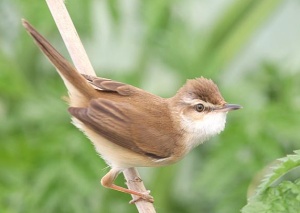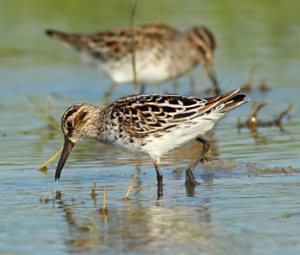|
On arrival we headed south to the Rhodope mountains and the next day we visited the dramatic Trigrad Gorge, not far from the border with Greece. (Bulgaria
borders 5 other countries.) There we had (eventually) stunning views of a very My new, collapsible walking stick was invaluable on some rough walks, although a lot of the birding was, fortunately, close to the road or at roadside because we were often travelling from centre to centre,(6 hotels in 10 days and several had many stairs and no lift. Rooms OK, bar one, and the food excellent, meals mostly chicken and pork, often with mushroom or other sauce, but we also had trout [good] and shark(!), we were assured that the species wasn't endangered.. Lots of Ice cream as some days were very hot, 25 to 28C and one day 30C.) Onwards to the Studen Kladenetz area where Griffon Vultures were common and several Egyptians seen (but no sign of the rare cinerous or black vulture), also
Ravens, hoodies, jackdaws etc. (In the Burgas region there is a a race of Jackdaw with a white spot and more grey, known as the Russian race.) The only problem with using my stick
was slight delay in using my binocs which inevitably meant I missed a few quick sightings. The shortest leg was to Madjarovo. Agricultural areas were incredibly productive with
Black-Headed and Corn Buntings everywhere, a large population of Calandra Larks (we were privileged to see a male doing a strange territoral jumping dance none of us, including the
guide,had ever seen before) plus Skylarks and Short-Toed Larks. Red-Footed Falcons, Kestrels and Hobbies hunted the semi-steppe areas. Neil put us on to 2 Stone Curlews, quite close
to the bus.There were several Bee-Eater colonies plus constant migration (big numbers heading north) so we saw many hundreds. Rollers regularly seen on wires.Cuckoos numerous.
Golden Orioles were everywhere and I called up several. We had excellent views of Barred, Olive-Tree, Olivaceous, Eastern Orphean, E.Bonelli's, Great Reed, Reed,Sub-Alpine warblers
plus Blackcap,Chiff-Chaff, also glimpses of a Sardinian but no wood or willow warbler. I had an Icterine but no one else saw it so it didn't go on the list. The best was incredible,
close views of a Marsh Warbler and a singing Paddyfield The Black Sea coastal lakes and lagoons were crammed with birds, lots of Dalmatian and White Pelicans; Purple , Grey & Night Herons, also Squacco; Great
and Little Egrets;Spoonbills; Gull-billed, Common, Sandwich, Little and Whiskered Terns; Pratincoles; Little Bitterns; surprising numbers of Mute Swan etc. Huge numbers of waders
including many hundreds of Curlew Sandpiper and Little Stint plus Temminck's. A highlight was no less than 5 Broad-Billed Sandpipers Most Bulgarians, including hotel staff outside cities, do not speak English. They nod for no and shake their heads for yes! They use the Cyrillic script (invented by St. Cyril c.860 AD after Tsar Boris converted the country to Christianity) so most signs unreadable, only in the cities are they also in English. Sofia is a very ancient city. In medieval times it was the capital and in the centre of a much bigger country, including what is now Macedonia. It was ruled by the Ottoman Turks 1396 - 1878. Several uprisings had been ruthlessly suppressed but finally the Russians helped Bulgaria to shake free of Turkish rule. During World War 2 it wasn't occupied but subject to Nazi control. King Boris the Third was poisoned on Hitler's orders. His young son, King Simeon 2nd went into exile in Spain. The Communist regime lasted from 1946 until 1989. In 2001 Simeon returned and the ex-king became prime minister of Bulgaria for 4 years! Supposedly the only time this has ever happened in the World. On the last day we travelled back from the Black Sea coast to Sofia, in the west, |
 active Wallcreeper from just beyond the road tunnel. (Also Honey Buzzards, Eastern Black Redstart etc.) Good job it wasn't a long trek like in the Pyrenees, which would
be beyond me now. Grey and White Wagtails were everywhere and we saw several White-bellied Dippers.
active Wallcreeper from just beyond the road tunnel. (Also Honey Buzzards, Eastern Black Redstart etc.) Good job it wasn't a long trek like in the Pyrenees, which would
be beyond me now. Grey and White Wagtails were everywhere and we saw several White-bellied Dippers. Warbler,both
responding to a recording .Latter species were late arriving so we were lucky. Isabelline, Black-eared and Northern Wheatears seen and great views of Pied Wheatears at Cape Kaliakra
and one other site, at the westernmost point of their range. The two PWs were a highlight of the trip for me. We saw Syrian, Great and Middle Spotted woodpeckers, also Green
(common)and Grey-Headed and (but not well) White-Backed plus Lesser Spotted for some, but missed black and wryneck completely. Nesting Semi-Collared Flycatchers were seen closely
and the eastern form of Common Redstart. Hawfinch were regularly seen. Many White Storks nesting and in remoter areas Black Storks were relatively common.
Warbler,both
responding to a recording .Latter species were late arriving so we were lucky. Isabelline, Black-eared and Northern Wheatears seen and great views of Pied Wheatears at Cape Kaliakra
and one other site, at the westernmost point of their range. The two PWs were a highlight of the trip for me. We saw Syrian, Great and Middle Spotted woodpeckers, also Green
(common)and Grey-Headed and (but not well) White-Backed plus Lesser Spotted for some, but missed black and wryneck completely. Nesting Semi-Collared Flycatchers were seen closely
and the eastern form of Common Redstart. Hawfinch were regularly seen. Many White Storks nesting and in remoter areas Black Storks were relatively common. . Numerous Avocets and Black Winged Stilts. Good range of ducks including Ferruginous and Garganey. Lots of
Med Gulls, also Slender-Billed, Caspian, Black Headed, Little and lots of Yellow-Legged ; Great Crested and Black-Necked Grebes on the sea. White-tailed Eagles were in evidence,
also Sparrowhawk. We watched a male Penduline Tit constructing a nest. The wildest country holds bears, wolves and wild boar but we didn't see anything bigger than wild goats and a
hare (but some saw a chamois). Strangely we saw no rabbits, instead there is the Suslik, a kind of ground squirrel that provides food for raptors, including 10 pairs of Imperial
Eagle (we had stunning views of a pair on territory cruising round above us for ages). Susliks were also on the menu for Eagle Owls and we had brilliant views of a female (on 2
occasions) sat out on a limestone cliff in the daytime. Rock Bunting was hard to find, Chukar even more so, but we saw both in the end. Single sightings of Golden Eagle and
Short-Toed Eagle. We were lucky to see a Fire Salamander crossing a (quiet) hillside road. A feast for the photographers.
. Numerous Avocets and Black Winged Stilts. Good range of ducks including Ferruginous and Garganey. Lots of
Med Gulls, also Slender-Billed, Caspian, Black Headed, Little and lots of Yellow-Legged ; Great Crested and Black-Necked Grebes on the sea. White-tailed Eagles were in evidence,
also Sparrowhawk. We watched a male Penduline Tit constructing a nest. The wildest country holds bears, wolves and wild boar but we didn't see anything bigger than wild goats and a
hare (but some saw a chamois). Strangely we saw no rabbits, instead there is the Suslik, a kind of ground squirrel that provides food for raptors, including 10 pairs of Imperial
Eagle (we had stunning views of a pair on territory cruising round above us for ages). Susliks were also on the menu for Eagle Owls and we had brilliant views of a female (on 2
occasions) sat out on a limestone cliff in the daytime. Rock Bunting was hard to find, Chukar even more so, but we saw both in the end. Single sightings of Golden Eagle and
Short-Toed Eagle. We were lucky to see a Fire Salamander crossing a (quiet) hillside road. A feast for the photographers. a gruelling 7 hours on the road but we also made some good stops a.m. On the last morning up at 5.00 am for an early morning
trip up a mountain in the Vitosha Range. There were still snow patches above the ski-station and the wind cut like a knife but we had our reward with very close views of a
Nutcracker, pair of Firecrests, Willow Tit, pair of Ring Ouzels, pair of Crag Martins still constructing their nest etc. (but missed the promised water pipit). The overall group
list (including a couple of heards) was 195, I scored 188. Most of us missed a full plumage Rosy Starling, disappointing as it was the only one seen. Another couple of days and 200
would probably have been achieved. I can highly recommend a tour of Bulgaria for anyone wanting to see a good range of Eastern Europe birds plus flower meadows in profusion,
impressive scenery and many butterflies.
a gruelling 7 hours on the road but we also made some good stops a.m. On the last morning up at 5.00 am for an early morning
trip up a mountain in the Vitosha Range. There were still snow patches above the ski-station and the wind cut like a knife but we had our reward with very close views of a
Nutcracker, pair of Firecrests, Willow Tit, pair of Ring Ouzels, pair of Crag Martins still constructing their nest etc. (but missed the promised water pipit). The overall group
list (including a couple of heards) was 195, I scored 188. Most of us missed a full plumage Rosy Starling, disappointing as it was the only one seen. Another couple of days and 200
would probably have been achieved. I can highly recommend a tour of Bulgaria for anyone wanting to see a good range of Eastern Europe birds plus flower meadows in profusion,
impressive scenery and many butterflies.